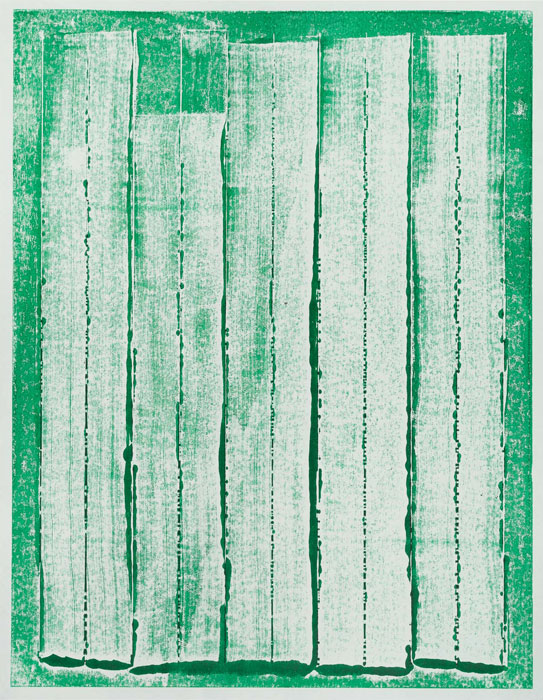Exhibition
in Zürich / Switzerland
- Gabriel Braun: o.T, 2015, Holzdruck auf gefärbtem Papier, 45 x 35 cm, Courtesy Petra Gut Contemporary
With his woodcuts, Gabriel Braun creates cool aesthetics in the long tradition of abstraction. When speaking of modern abstraction, it is common to think of the beginning of the 20th Century and to associate its early days with art-historical styles such as Suprematism, Constructivism, De Stijl and Bauhaus.
Gabriel Braun uses geometrical forms such as circles, triangles or rectangles. All of them have in common the fact that they represent reduced forms. The motives are repeated in varying colours. As a result of the serial arrangement of the woodcuts above and next to each other, a special rhythm arises.
The geometrical compositions have a sensual impact, since the wood grain and tiny woodchips on the printing blocks leave traces behind. The shapes blur slightly and appear irregularly frayed and consequently turn picturesque. In Gabriel Braun’s objects geometry and precision unite. The forms reach into depth or spread across space. The grain of the MDF boards at times create graphic ornaments.
While paintings in their two-dimensionality pre-define a fixed position of the viewer, sculptures in their three-dimensionality require an active involvement from different perspectives. The movement of the viewer is necessary. Depending on the position, Gabriel Braun’s objects change from triangle to pyramid, from circle to cylinder or from rectangle to prism.
In this respect Gabriel Braun’s sculptures remind of the novel “Flatland” (1884) by the British author Edwin A. Abbott. The inhabitants of Flatland, who are represented in the shape of geometrical figures, live in a two-dimensional world. The narrator of the novel, the square, coincidentally discovers the spatial, three-dimensional world – Spaceland. However, he cannot convince his fellow inhabitants of this multi-dimensionality. In “Flatland”, geometry is only superficially dealt with. “The secret of four, five or even six dimensions”, as Abbott notes, are connected to an extension of the imaginative power of our thinking.
Gabriel Braun piles up two-dimensional boards turning them into three-dimensional geometry and glues the individual parts together in the spirit of Abbott: “The continuous growth of dimensions from point to figure leaves us”, according to the square “to conclude the existence of multidimensional dimensionalities by means of analogy …”. With Gabriel Braun the viewer is challenged to make the association: all of the objects surrounding us are made up of simple geometrical forms. They appear as an abstraction of reality.
Gabriel Braun, born in 1982, studied at the UDK Berlin from 2004 -2009. In 2007, he participated in a study exchange program to the Iceland Academy of the Arts. In 2010, he was a master-class student of Pia Fries.
Gallery hours Wed-Fri 11 am – 6:30 pm, Sat 10 am – 4 pm
Gabriel Braun schafft in seinen Holzschnitten eine coole Ästhetik in der langen Tradition der Abstraktion. Wenn man von modernistischer Abstraktion spricht, denkt man an den Beginn des 20. Jahrhunderts und assoziiert deren Anfänge mit den kunsthistorischen Stilrichtungen wie Suprematismus, Konstruktivismus, De Stijl und Bauhaus.
Gabriel Braun verwendet geometrische Formen wie Kreise, Dreiecke oder Rechtecke. Allen gemeinsam ist, dass es sich um reduzierte Formen handelt. Die Motive wiederholen sich in abgeänderter Farbigkeit. Durch die serielle Anordnung des Über- und Nebeneinanders der Holzschnitte ergibt sich ein spezieller Rhythmus.
Die geometrischen Kompositionen wirken sinnlich, da die Holzmaserung und kleine Späne auf den Druckstöcken Spuren hinterlassen. Die Formen verschwimmen leicht und fransen unregelmäßig aus, wodurch sie etwas Malerisches bekommen. In Gabriel Brauns Objekten vereinen sich Geometrie und Präzision. Die Formen ziehen sich in die Tiefe oder breiten sich in den Raum aus. Die Maserung der MDF Platte lässt an manchen Schnittflächen zeichnerische Ornamente entstehen.
Während Bilder in ihrer Zweidimensionalität einen fixen Standort des Betrachters vordefinieren, verlangen Skulpturen in ihrer Dreidimensionalität eine aktive Auseinandersetzung aus verschiedenen Perspektiven. Die Bewegung des Betrachters ist notwendig. Je nach Standpunkt verändern sich Gabriel Brauns Objekte vom Dreieck zur Pyramide, vom Kreis zum Zylinder oder vom Rechteck zum Prisma.
In diesem Punkt erinnern Gabriel Brauns Skulpturen an den Roman “Flatland” (1884) des Briten Edwin A. Abbott. Die Bewohner von Flatland, die die Gestalt geometrischer Figuren haben, leben in einer zweidimensionalen Welt. Der Erzähler des Romans, das Quadrat, entdeckt zufällig die räumliche, dreidimensionale Welt – Spaceland. Allerdings kann er seine Mitbewohner nicht von dieser Mehrdimensionalität überzeugen. In “Flatland” geht es nur vordergründig um Geometrie. “The secret of four, five or even six dimensions”, wie Abbott schreibt, wird mit der Erweiterung der Vorstellungskraft unseres Denkens in Verbindung gebracht.
Gabriel Braun stapelt zweidimensionale Platten zu dreidimensionalen Geometrien und verleimt diese Einzelteile im Sinne von Abbott: “Das kontinuierliche Anwachsen der Dimensionen von Punkt zu Körper lasse” so das Quadrat “mittels Analogie auf weitere mehrdimensionale Dimensionalitäten schließen… “. Bei Gabriel Braun wird der Betrachter zur Assoziation aufgefordert: alle uns umgebenden Objekte sind aus einfachen geometrischen Formen aufgebaut. Sie erscheinen als Abstraktion der Realität.
Gabriel Braun, geboren 1982, studierte von 2004 -2009 an der UDK Berlin. 2007 nahm er an einem Studienaustauschprogramm an der Iceland Academy of the Arts teil. 2010 war er Meisterschüler bei Pia Fries.
Öffnungszeiten Mi-Fr 11 – 18.30 Uhr, Sa 10 – 16 Uhr
Location:
Petra Gut Contemporary
Kreuzstrasse 15
8008 Zürich
Switzerland


